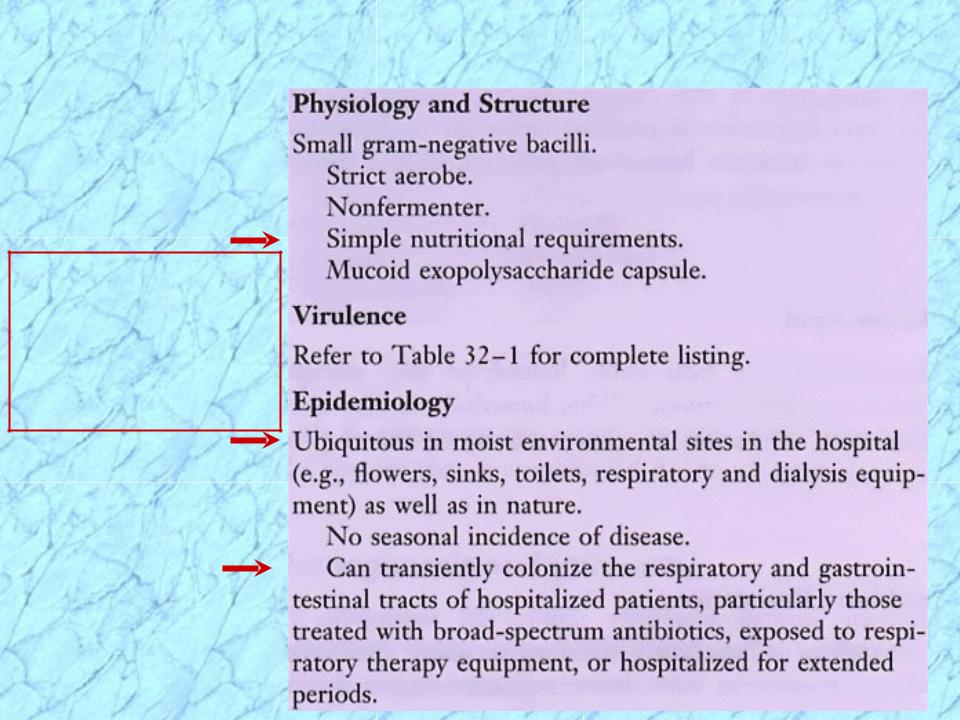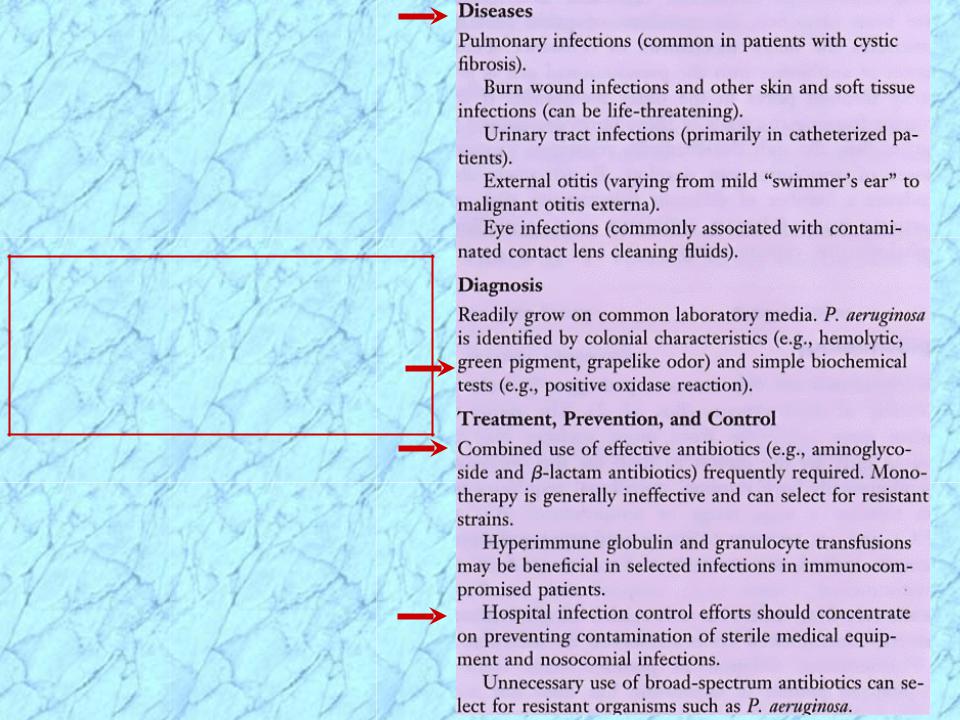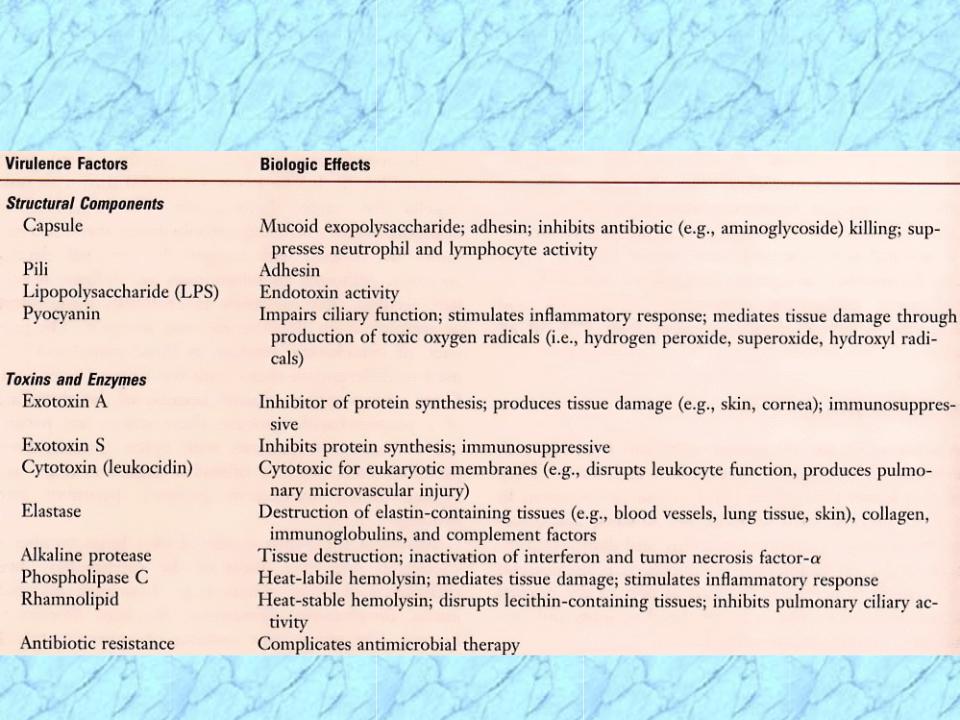
- •Pseudomonas
- •General Overview
- •General Characteristics of Nonfermenters
- •Clinically Important Nonfermentative
- •Pseudomonas
- •Characteristics of Pseudomonas aeruginosa
- •Pseudomonas aeruginosa Infections
- •Pseudomonas
- •Virulence Factors Associated with Pseudomonas aeruginosa
- •Mechanism of Action of Exotoxin A
- •Mechanisms of Antibiotic Resistance
- •Burkholderia cepacia
- •Diseases Associated with Burkholderia spp.
- •Stenotrophomonas
- •Stenotrophomonas maltophilia
- •Stenotrophomonas maltophilia (cont.)
- •Stenotrophomonas maltophilia (cont.)
- •Acinetobacter
- •Acinetobacter baumanii
- •Moraxella catarrhalis
- •Moraxella catarrhalis
- •REVIEW
- •General Characteristics of Nonfermenters
- •Clinically Important Nonfermentative
- •Review of
- •Characteristics of Pseudomonas aeruginosa
- •Pseudomonas aeruginosa Infections
- •Pseudomonas
- •Virulence Factors Associated with Pseudomonas aeruginosa
- •Mechanism of Action of Exotoxin A
- •Mechanisms of Antibiotic Resistance
- •Review of Burkholderia cepacia
- •Diseases Associated with Burkholderia spp.
- •Review of
- •Stenotrophomonas maltophilia (cont.)
- •Review of
- •Acinetobacter baumanii
- •Review of Moraxella catarrhalis
- •Moraxella catarrhalis


Pseudomonas
and
Nonfermenters

General Overview
Opportunistic Pathogens of Plants, Animals, and Humans
Many Taxonomic Changes in Last Decade
Clinically Important Aerobic Gram-Negative Bacilli Include:
•Aerobic nonfermenters: 10-15% of clinical isolates
Pseudomonas aeruginosa; Burkholderia cepacia; Stenotrophomonas maltophilia; Acinetobacter baumannii; Moraxella catarrhalis: Account for >75% of all clinical isolates of aerobic nonfermenters
•Facultative anaerobes and microaerophiles: 70-80% of clinical isolates
•Haemophilus & related organisms: 10-15% of clinical isolates
•Unusual bacilli: <1% of clinical isolates
Pseudomonads Classified into Five rRNA Groups

General Characteristics of Nonfermenters
Oxidative gram-negative bacilli, including Pseudomonas spp., produce acid from glucose or other carbohydrates only in the presence of oxygen (nonfermenters).
•NOTE: Enterobacteriaceae, Aeromonas and
Vibrio are fermentative and can utilize carbohydrates in the absence of oxygen.
Pseudomonas aeruginosa oxidizes but does not ferment glucose. Alcaligenes faecalis neither ferments nor oxidizes glucose (see Lab Manual).

Clinically Important Nonfermentative
Gram-Negative Bacilli
Lab only
 Later
Later


Pseudomonas
aeruginosa
(Family Pseudomonadaceae)

Characteristics of Pseudomonas aeruginosa
Motile (by single or multiple polar flagella) gram-negative rods
Obligate (strict) aerobes (most strains)
Oxidase (usually) and catalase positive
Nonfermentative chemoheterotrophic respiratory metabolism
Minimal nutritional reqts.; Many organic compounds used as C and N sources, but only a few carbohydrates by oxidative metabolism
•Glucose used oxidatively
•Lactose negative on MacConkey’s agar
Some strains produce diffusible pigments:
•Pyocyanin (blue); fluorescein (yellow); pyorubin (red)
P. aeruginosa produces characteristic grape-like odor and blue-green pus & colonies
Broad antibiotic resistance

Pseudomonas aeruginosa Infections
Survive where most organisms cannot; e.g., “oil-eating” bacteria are
Pseudomonas.
(Slime layer) 

Pseudomonas
aeruginosa
Infections (cont.)
Characteristic grape-like odor. Bluish-green color clinically and in the lab due to presence of two pigments: pyocyanin & fluorescein.

